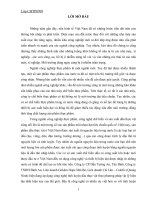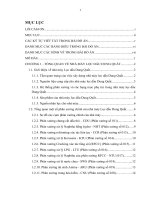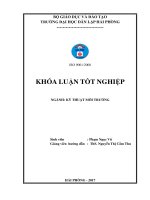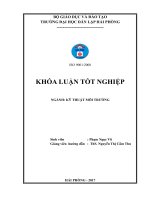xử lý môi trường ở nhà máy lọc dầu dung quất
Bạn đang xem bản rút gọn của tài liệu. Xem và tải ngay bản đầy đủ của tài liệu tại đây (2.03 MB, 42 trang )
Integrated environmental management
in Dung Quat refinery
Priority for environmental management
1. Reduce
2. Reuse
4. Final Treatment
Waste
Raw material
• Using efficient energy
• Improve technology
• Saving
• Cleaner production
1. Reduce
2. Reuse
3. Recycle
1. Reduce
2. Reuse
4. Final Treatment
3. Recycle
1. Reduce
2. Reuse
1. Reduce
2. Reuse
4. Final Treatment
1. Reduce
2. Reuse
3. Recycle
4. Final Treatment
1. Reduce
2. Reuse
Air pollution control
Source of emissions
– Pollutants discharged from 11 stacks of
refinery including SO
2
, NOx, CO, HC…
– Dust generated from transportation
activities within refinery
– Leakage, fugitive emission from tank,
pipeline and equipment vents
– Heat and radiation from units, fire heater
and flare
– Noise and vibration from power plant and
rotating equipments
Air pollution control
• Cleaner production— prevention, redesign
Changing fuel, removal pollutant from raw
material
Changing technologies
Increasing inspection and maintenance
Operating procedures — production
coordination
• Recycle
• End-of-Pipe control
Particles control devices
Gaseous pollutants control devices
Approaches to Emission Control
PROCESS
Cleaner
production
Control
Devices
Reduced
emission
Stack
Cleaner
production
Control
Devices
Air pollution control
Cleaner production (treatment at the source)
• Remove H
2
S out of gas (Gas Plant, LTU)
(C
2
H
4
ỌH)
2
NH (DEA) +H
2
S (C
2
H
4
OH)
2
NH
2
HS
• Remove S out of raw material (NHT, LCO hydrotreater Unit)
S+H
2
=H
2
S
• Purpose: - Catalyst protection
– Improve quality of product Protection of Environment
• Amine regeneration:
(C
2
H
4
OH)
2
NH
2
HS (C
2
H
4
OH)
2
NH + H
2
S
SRU
Recycle back to
absorption units
Air pollution control
• Treatment of gas streams (rich H
2
S) from unit ARU, CNU,
SWS
• Purpose: - Protect of Environment
– Recovery of Sulfur
• H
2
S gas is very toxic, odor (rotten egg) S (solid) is easy to
handle and control and it can be sold for fertilizer production
• Reaction for S recovery (Gauss)
H
2
S + 3/2 O
2
= SO
2
+H
2
O
SO
2
+2H
2
S = 3S+2H
2
O
3H
2
S + 3/2 O
2
= 3S+2H
2
O
• Sulfur Recovery from H
2
S gas stream
Air pollution control
Cleaner production (treatment at the source)
End of Pipe control
• Particle matter (PM) control
– Cyclones (precleaners)
• Located within reactor of RFCC for primary removal
catalyst out of oil vapor
• They are often used to reduce the inlet loading of PM to
downstream collection devices by removing larger,
abrasive particles
• Cyclones are used to control PM, and primarily PM
greater than 10 micrometers
• Particle matter control
– Electrostatic Precipitator (ESP)
Gas stream from regenerator of RFCC containing high
concentration of PM (1200mg/m
3
) whereas environmental
standard (TCVN 5939-1995) is 400 mg/m
3
Using ESP to remove PM to meet standard. Advantages of
ESP
• High collection efficiency (99÷%)
• Treats large volumes of gas
• Produces only low pressure drops
• Economical to operate
• Offers dry collection of valuable products
• Generates dry waste for disposal or recycle
End of Pipe control
Feed Residue
Air
DeSOx
CO Boiler
WHB
Reactor/Regenerator
Steam
Economizer
MTC
Discharge
electrodes
Flue gas in
Clean
gas out
Hoppers
Rappers
ESP
Electrostatic Precipitator (ESP)
End of Pipe control
Air pollution control of RFCC unit
• Control SOx (DeSO
x
)
SOx formed when burning oil or gas containing S
S + O
2
= SO
2
– When processing BachHo crude oil, SO
2
in emission from
Dung Quat refinery is lower than TCVN 5939-1995
(500mg/Nm
3
). Removal of SO
2
is not necessary
– When processing sour crude oil or TCVN is more
stringent, it is required to equip SO
2
control devices
End of Pipe control
• Control SOx (DeSO
x
)
Using Ca(OH)
2
, NaOH, Mg(OH)
2
, CaCO
3
to absorb SO
2
,
the reaction as follow:
– SO
2
+ Ca(OH)
2
+ H
2
O => CaSO
3
.1/2H
2
O + 3/2H
2
O
– CaSO
3
.1/2H
2
O + 3/2H
2
O + 1/2O
2
=> CaSO
4
.2 H
2
O
– SO
2
+ CaCO
3
+ 1/2 H
2
O => CaSO
3
.1/2H
2
O (Oxidation
to CaSO
4
.2H
2
O)+ CO
2
–
End of Pipe control
Make-up
water
Recirculation
tank
Pump
Feeder
Alkaline
storage
tank
Treated liquid Purge
liquid
Recirculation
liquid
Mist
eliminator
spray water
Exhaust to
atmosphere
Inlet gas
stream
∆
p
∆
p
T
F
P
pH
T
T
Typical process flow diagram for alkaline (Ca(OH)
2
, NaOH… ) scrubbing
High concentration
of SO
2
End of Pipe control
• Formation of NOx from air Nitrogen
– NO increases with T°C, significant at >700°C
– NOx in flue gas: 500-1000 ppm (90% NO + 10% NO
2
)
• Concentration of NO
x
of flue gas in Dung Quat refinery is
lower than TCVN 5939-1995 (1000mg/Nm
3
), treatment of this
gas is not required.
• But when standard is more stringent, treatment may be
required
Control NO
x
• Pre-combustion:
– Fuel choice: fuel gas
– NOx emission >oil>fuel gas
• During combustion: low NOx burner (for air N2)
– Important comb. factors & design for NOx control
• Combustion temp. control: avoid high peak T°C; Avoid high heat release & achieve
high heat removal; Minimize residence of mixture time at high temp. zone
• Extend of combustion-zone cooling of primary flame zone (heat transfer to
surrounding > heat removal)
• Furnace configuration: firing methods for heat removal (tangential firing reduces
NOx by 50-60%)
– Combustion modification techniques
• Flue-gas recirculation: portion of cooled gas injected into combustion zone =>
reduce T°C & O2
• Two-stage or off-stoichiometric combustion: First stage: air — 85-95% of stoich. =>
reducing env => O2 & low temp. => low NOx
2 stage: inject secondary air downstream oxidize at lower T°C downstream > low NOx
Control NOx
• Post-combustion: DeNOx
– Selective catalytic reduction (SCR):
Reactant (CO, NH
3
etc.) selectively react with NO
x
in presence of
catalyst => reduces NO
x
to N
2
and O
2
CO as reducing agent, Pt catalyst reaction as follow:
2CO + 2NO = CO
2
+N
2
4CO + 2NO
2
= 4CO
2
+ N
2
– Selective non-catalytic reduction (SNCR):
Injection of reactants (NH
3
or urea based compounds) with high T
o
(optimum: 930-1090
o
C ) => high activation, no need catalyst
Reactant: NH
3
4NH
3
+ 6NO = 5N
2
+ 6H
2
O
Control NOx
Typical process flow diagram for removal of NOx using SCR
Control NOx
Wastewater Management
Segregation of effluent streams
• Importance of segregation of the waste water into
different streams:
– For reduce, reuse and recycle. Each stream is
characterized with different properties
– For applying different methods of treatment
– Some streams required to treat, the other are not
required to meet TCVN 5945-1995
Classification of effluent streams
• The typical sources of effluent streams in Dung
Quat Refinery are:
– One through cooling water
– Storm water
– Oily Surface Water (OWS)
– Oily Water (OW)
– Stripped Sour Water (high concentration of phenol)
Management of wastewater
• One through cooling water
– Properties:
• Seawater
• For cooling of fresh water
• Outlet is 8
o
C higher than inlet
• Biocide injected (HOCl
3
)
– Treatment:
Direct discharge to the sea, but
Monitoring
• Temperature
• Residue Chlorine
Verify the
compliance
with the TCVN
5945
Monitoring
• Temperature
• Residue Chlorine
• Raining/storm water
– Properties:
• The first 55 mm raining water containing oil and suspended
solid (SS) so it is considered as OWS
• If it is higher than 55mm it is characterized as SS only
– Treatment:
• The first 50mm raining water is treated as OWS (will be
discussed later)
• The next raining it is discharged directly to the sea
Storm Basin
Flow splitter
box
Raining
water
SEA
50mm of
raining water
CPI
Management of wastewater
OWS comprises surface water run-off from areas that are at risk
of hydrocarbon contamination as a result of spillage or
malfunction. Normally, any contamination would be light and
amenable to basic treatment.
OWS comprises water run-off from:
– paved process areas
– specific bunded / kerbed areas
– truck and tanker loading / unloading areas.
The following utility effluents are also classed as OWS:
– freshwater filters (backwash)
– neutralised effluent from demineralisation plant
– condensate recovery system filters (backwash)
– fresh cooling water system purge and drain
Management of wastewater
• Oily Surface Water (OWS)
– Properties of OWS
• Oil: 50 mg/L
• SS: 50 mg/L
• BOD: 50mg/L
• COD: 200 mg/L
– Treatment
CPI
Mixed with high
concentration
of phenol stream for
further treatment
OWS
Management of wastewater
• Oily Surface Water (OWS)
CPI
Mixed with high
concentration
of phenol stream for
further treatment
CPI
Mixed with high
concentration
of phenol stream for
further treatment
•Stripped Sour Water (SSW)
– Properties:
Phenol: 258mg/L
– Treatment (Primary treatment)
Due to the high phenol content in this stream and the stringent standard
imposed on phenol residuals (0.05mg/L), it is treated by activated sludge
treatment after cooling and coagulation step. The pre-treated effluent is
directed to balancing tank.
Heat
exchanger
Return sludge
BALANCE
TANK
Excess sludge
to thickener
Biological
treatment
Chemicals
Clarifier
SSW
Management of wastewater
OWS









